In-Depth Review of AMD Radeon RX 6600 8GB Graphics Card
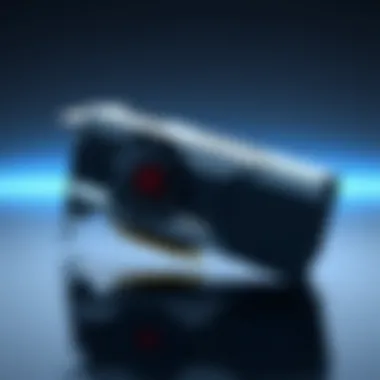
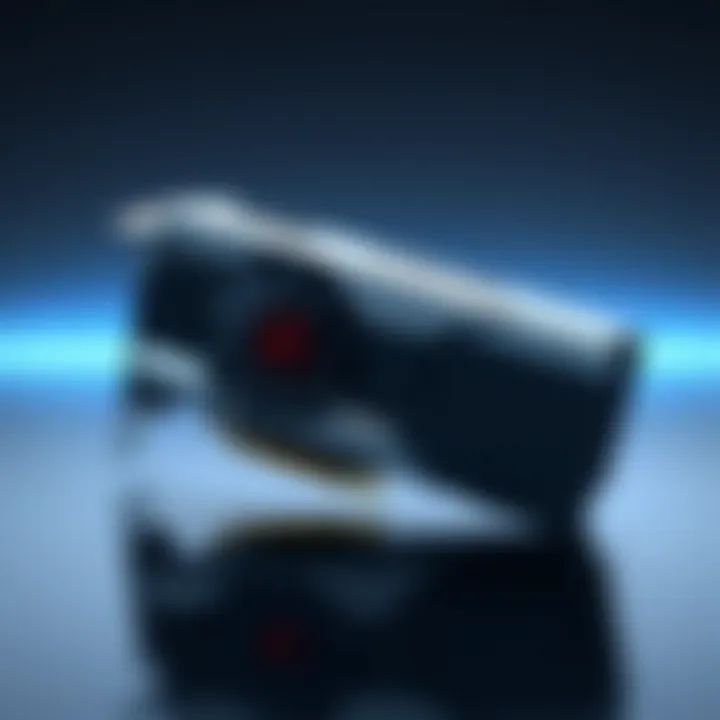
Intro
The landscape of graphics cards is ever-evolving, with enthusiasts always on the hunt for the next best thing. The AMD Radeon RX 6600 8GB stands at the forefront of this quest, promising a mix of performance and value that appeals to both gamers and IT professionals. As a mid-range GPU, it boldly claims its turf in a competitive market. The question is, how does it stack up against its contemporaries?
In this analysis, we will take a closer look at the core aspects of the RX 6600 8GB. From essential specifications to real-world performance metrics, we'll cover what sets it apart from the pack. It's not just about numbers and technical jargon; it's about understanding what this graphics card can do in practical scenarios—be it gaming, creative work, or general computation. Additionally, we will dissect its features, weigh its strengths and weaknesses, and assess its overall value for money in today’s market, providing you with the kind of insight that might just help you make an informed purchasing decision.
Let's delve deeper into what makes the AMD Radeon RX 6600 8GB a noteworthy contender in the graphics card arena.
Foreword to AMD Radeon RX 8GB
The AMD Radeon RX 6600 8GB serves as an interesting focal point in the crowded GPU market. The importance of this graphics card can't be overstated, particularly for gamers and tech enthusiasts who seek performance without the price tag of high-end models. Understanding the nuances of the RX 6600 is crucial for making informed decisions, especially as the competition among graphics cards heats up. This section lays the groundwork for discussing everything from performance to market reception, ensuring readers grasp why the RX 6600 8GB is a contender worth examining.
Overview of AMD Radeon Series
The AMD Radeon series has long been a staple in the world of gaming graphics. With products catering to a range of users — from casual gamers to hardcore enthusiasts — the RX 6600 fits neatly into AMD's evolving lineup. Previous iterations, such as the RX 5000 series, established a strong foundation, but the RX 6000 series marks a significant leap forward.
The RX 6600, specifically, leverages the RDNA 2 architecture, promising improved performance while being more power-efficient than its predecessors. This architecture not only enables better frame rates but also incorporates features that appeal to modern gamers, like ray tracing capability. To paraphrase the old saying, you can’t teach an old dog new tricks, but AMD has definitely learned from past experiences and translated that knowledge into the RX 6600.
Key features include:
- Enhanced energy efficiency that helps reduce ongoing costs.
- Compatibility with a wide array of games now requiring powerful GPUs.
- Solid balance between performance and price, meaning it won’t break the bank.
Positioning of the RX in the Market
When it comes to positioning, the RX 6600 is squarely aimed at the mid-range segment. It's neither the top dog nor the budget-friendly option, but it situates itself in a sweet spot that appeals to many users. As gaming demands heighten, the RX 6600 addresses both casual and moderately serious gamers looking to upgrade without stretching their wallets too thin.
Compared to competitors like NVIDIA’s GeForce GTX 1660 Super or even the RTX 3060, the RX 6600 puts up a solid fight. It delivers a compelling array of features tailored for 1080p gaming. Given that many players indulge in esoteric titles or AAA games these days, achieving appropriate frame rates at respectable resolution becomes paramount. In essence, the RX 6600 steals the spotlight in terms of value, giving a good run to competing GPUs without asking users to compromise much on performance or quality.
The AMD Radeon RX 6600 8GB offers a fine balance of specs and pricing, making it a go-to choice for gamers who don’t want to overspend on their next upgrade.
By framing the RX 6600 within the larger context of AMD’s architecture and competitive landscape, we set the stage for a deeper dive into its technical specs and performance metrics. Understanding where it stands in the market is essential for recognizing its place in the overall ecosystem of graphics cards.
Technical Specifications
Understanding the technical specifications of the AMD Radeon RX 6600 8GB is paramount for assessing its performance and suitability for various applications. Technical specifications offer a window into the capabilities of the graphics card, allowing enthusiasts and professionals alike to gauge whether it meets their specific needs. They play a crucial role in performance benchmarks, influencing everything from gaming frame rates to multitasking efficiency. By dissecting these elements, one can appreciate how AMD positioned this GPU within the competitive landscape.
Key Hardware Features
GPU Architecture
The heart of the AMD Radeon RX 6600 is its GPU architecture, known as RDNA 2. This architecture builds on its predecessor by improving power efficiency and performance per watt. One of the standout characteristics of RDNA 2 is its support for hardware-accelerated ray tracing, a visual enhancement that brings games closer to real-world lighting and reflections. The shift from GCN (Graphics Core Next) to RDNA (Radeon DNA) wasn’t just rebranding; it represented a significant leap toward producing more effective performance for modern games.
A key benefit of RDNA 2 is its ability to deliver excellent graphics quality without excessively taxing the power supply, allowing users to maintain high frame rates even in visually demanding scenarios. However, while RDNA 2 offers compelling features, it isn't a total goldmine; the reliance on specific software optimizations means not every game benefits equally from its enhancements.
Stream Processors
Stream processors are the muscle behind the graphics card's processing. With the RX 6600, users get 1,792 stream processors at their disposal. This number may appear to be modest compared to higher-tier options, but it’s essential to recognize how AMD optimized these processors for various workloads. Each stream processor serves as a core that executes instructions, making the efficacy of these cores pivotal for rendering performance.
This GPU is particularly appealing because of its balance between power consumption and output. In scenarios where power efficiency is as critical as raw performance—such as in compact builds or quiet systems—these stream processors shine. However, one must note that having fewer stream processors compared to competitors may impact performance in highly parallel tasks like computing simulations.
VRAM Capacity
The 8GB of GDDR6 VRAM in the RX 6600 does not just provide ample space for textures and assets; it also ensures smoother gameplay as the resolution increases. With more games adopting higher-resolution textures and increasingly complex scene rendering, having sufficient VRAM is becoming less of a luxury and more of a necessity. For users playing at 1080p or 1440p, the VRAM likely proves to be more than adequate, allowing for the management of intricate graphics without noticeable slowdowns.
On the flip side, while 8GB is solid for current demands, those looking forward to the future might start to wonder if this capacity will hold up as gaming trends evolve and textures become richer. In essence, the VRAM serves as a double-edged sword; it performs excellently now but may raise questions for future-proofing.
Thermal Design Power (TDP)
The thermal design power of the RX 6600 caps at around 132 watts, which is relatively low for a GPU in its performance tier. This low TDP means less heat generation, which contributes to quieter operation and offers an advantage for builds focused on airflow and noise reduction. The efficient power usage allows gamers to forego bulky cooling solutions, making it easier for users to keep their systems cooler and quieter without excessive overhead.
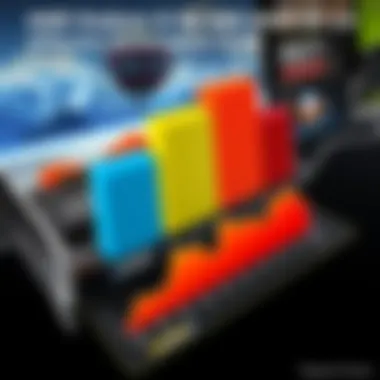
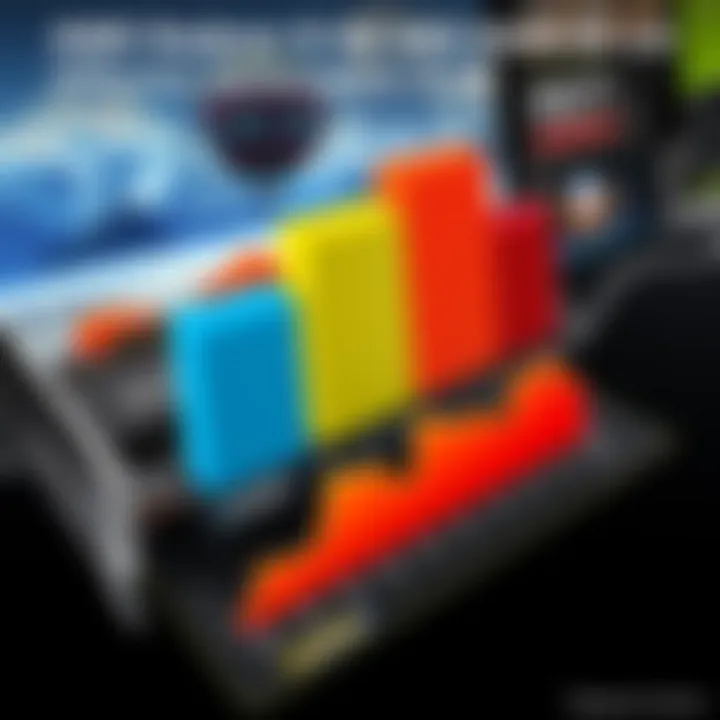
Connectivity Options
Connectivity is where the RX 6600 excels, providing versatility for various display setups. It includes multiple DisplayPort outputs and HDMI, catering to today's high-resolution monitors and the next gen of VR displays.
Display Outputs
The RX 6600 features three DisplayPort 1.4 connections and one HDMI 2.1 port. This configuration ensures compatibility with the latest monitors, supporting high refresh rates and resolutions. Users can effectively connect multiple displays for a modified workstation or gaming setup without significant juggling on outputs. Moreover, this broad support for different displays makes it an appealing choice for content creators who need versatile output options.
However, it’s worth noting that while the HDMI 2.1 enables up to 8K resolutions at 60Hz, most users will find significant value at lower resolutions. Having three DisplayPorts is a boon for multi-monitor setups, but remember, if you’re considering a single output configuration, you might not see the full advantage of this connectivity.
Interface Standard
The interface standard of the RX 6600 uses PCIe 4.0, which provides ample bandwidth for data transfer between the GPU and the motherboard. This standard enhances performance in high-demand applications and games, ensuring that the card operates efficiently without bottlenecks. The shift to PCIe 4.0 is significant, particularly when paired with modern motherboards that support this standard.
This choice of interface supports future expansions and compatibility with other hardware components. However, the caveat exists whereby older systems may not fully utilize PCIe 4.0’s capabilities, which could limit performance in certain scenarios.
In summary, the AMD Radeon RX 6600 8GB presents a well-rounded selection of technical specifications, with each component working harmoniously to deliver strong performance while remaining efficient. Understanding these specifications helps to place the RX 6600 within the broader context of the existing hardware landscape and may guide potential buyers toward informed decisions.
Performance Analysis
Performance analysis serves as the backbone for understanding how the AMD Radeon RX 6600 8GB fits into the holistic landscape of graphics processing units. As gamers and tech enthusiasts increasingly demand higher performance for demanding tasks such as gaming, content creation, and simulations, examining performance metrics becomes paramount. This section aims to unravel the core capabilities of the RX 6600, delving into benchmarks, real-world gaming experiences, and comparative performance against other GPUs. By focusing on these elements, readers can make informed decisions about whether this GPU aligns with their needs.
Benchmarks Across Popular Games
Testing the RX 6600 across a variety of popular games reveals a great deal about its performance. When we dive into real-world benchmarks like those from titles such as Cyberpunk 2077, Call of Duty: Warzone, and Red Dead Redemption 2, we can see how this GPU holds its own.
- Frame Rates: The RX 6600 consistently achieves impressive frame rates, especially at 1080p resolutions where it tends to outperform many competitors in similar price ranges. This capability makes it ideal for gamers who value smooth gameplay and quick response times.
- Graphics Settings: Beyond mere frame rates, the card performs well at high settings, allowing gamers to enjoy visually rich environments without sacrificing performance. Titles that often drop in performance on lesser cards run smoothly on the RX 6600, showcasing its robustness.
Considering this, it's evident that benchmarks inform not only the technical prowess of the RX 6600 but also the overall gaming experience it provides, making it a compelling choice for a wide audience.
Comparison with Competing GPUs
When juxtaposed with other graphics cards such as the Nvidia GeForce GTX 1660 Super and the GTX 3060, the RX 6600 positions itself favorably. While the GTX 3060 offers superior performance at higher resolutions, the RX 6600 excels in 1080p scenarios, often being more cost-effective. This comparison highlights AMD's knack for delivering value, especially in price-sensitive brackets.
- Performance-to-Price Ratio: One key characteristic that stands out is the performance-to-price ratio, where the RX 6600 often edges out its competitors. Its ability to maintain high frame rates without a hefty price tag appeals to budget-conscious gamers.
- Use Cases: While competing GPUs might excel in ray tracing capabilities, the RX 6600 stands tall in traditional rasterization, providing gamers focused more on frame rates than on cutting-edge effects an excellent option.
Real-World Gaming Experience
Delving deeper into the real-world gaming experience, we can break down critical aspects like frame rates and resolution handling, which are vital in affecting overall enjoyment and performance during gaming sessions.
Frame Rates
Frame rates are arguably one of the most critical metrics when assessing performance. High frame rates lead to smoother gameplay, which is essential for fast-paced titles. The RX 6600 typically operates around 60-120 fps depending on the game and settings.
- Consistency: The card performs remarkably well in maintaining consistent frame rates across a variety of genres, from first-person shooters to expansive open-world adventures.
- Competitive Advantage: For competitive gamers, every frame matters. The RX 6600’s capable performance provides an edge, ensuring actions appear fluid and responsive, which is crucial during intense gaming moments.
Resolution Handling
Resolution handling is another significant factor to consider. The RX 6600 shines particularly well at 1080p and can also handle 1440p with some adjustments in settings.
- Versatility: Gamers often switch between titles with varying demands. The RX 6600 is well-equipped to handle different resolutions with grace, ensuring that users do not feel limited.
- Trade-offs: While it performs admirably at higher resolutions, users may need to lower some graphic settings in graphically intensive titles for optimal performance, which is a typical trade-off in this segment.
Architecture and Technology Insights
Understanding the architecture and technology behind the AMD Radeon RX 6600 8GB graphics card is crucial as it sets the foundation for performance and functionality. This section will delve into its RDNA architecture and ray tracing capabilities, providing insights that resonate strongly with tech enthusiasts and gamers alike. These technical aspects often dictate not only how well a GPU performs in various scenarios but also how it compares to others in its class. The AMD Radeon RX 6600 has carved its niche, blending performance with modern gaming requirements, ensuring it provides bang for your buck.
RDNA Architecture Overview
The RX 6600 is built on AMD's RDNA architecture, an advancement that has shifted the landscape of graphical computing. RDNA stands for
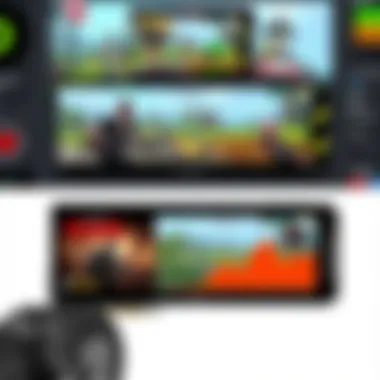
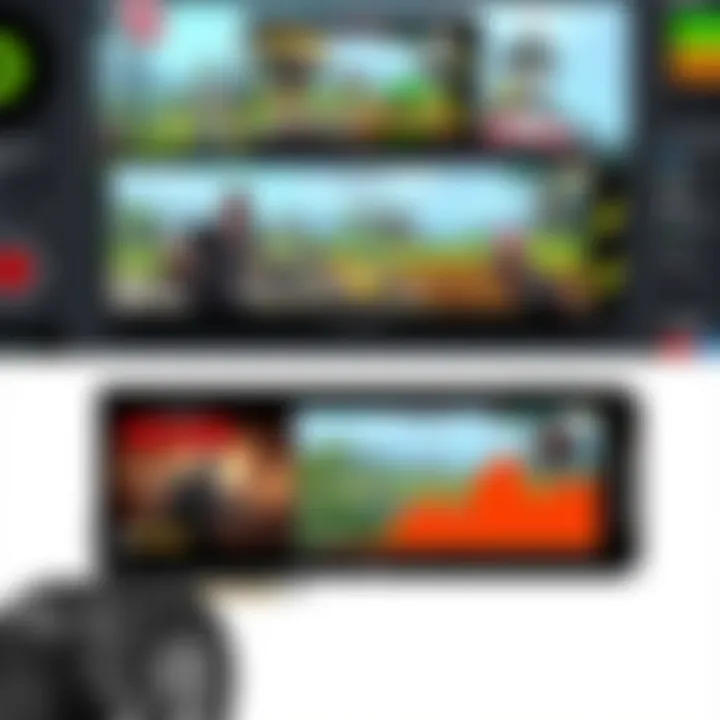
Power Consumption and Efficiency
Understanding power consumption and efficiency is crucial when analyzing the AMD Radeon RX 6600 8GB GPU. As energy costs continue to rise and environmental concerns grow, consumers are increasingly focused on not just how well a graphics card performs, but also how efficiently it uses power. Efficiency impacts not only utility bills but also system heat generation, which can affect the longevity and performance of components.
Idle and Load Power Metrics
When considering a graphics card, one of the key metrics to observe is how much power it consumes both while idle and under load. For the RX 6600, the idle power consumption is impressively low, hovering around 10-15 Watts. This is significant because it means that when the system is not being pushed hard, it will not draw much power—ideal for users intending to run the card 24/7 or using it for casual tasks.
Under load, when gaming or performing graphic-intensive tasks, the RX 6600’s power draw can escalate up to about 130-150 Watts. While this is not the lowest consumption figure on the market, it remains moderate considering the performance output. Most modern gamers appreciate these numbers, as they indicate a balance between performance and efficiency.
"A graphics card's efficiency plays a pivotal role in keeping your entire system powered without breaking the bank."
Impact on System Build
The power scalability of the Radeon RX 6600 contributes significantly to how users should approach their system builds. When selecting a power supply unit (PSU), it is essential to ensure it can handle the graphics card's requirements. With a recommended PSU rating of around 500 Watts, users have flexibility in choosing an adequate power source without overspending on highly-rated options.
Moreover, the efficiency rating of the PSU, indicated by 80 Plus ratings, should also be considered. A power supply that boasts 80 Plus Gold or Platinum ratings ensures that more energy is efficiently converted into usable power rather than being wasted as heat. This not only contributes to lower electricity bills but also aids in system cooling—an essential factor for maintaining optimal performance of the RX 6600 during demanding tasks.
To summarize, the power consumption and efficiency of the AMD Radeon RX 6600 play a significant role in its value as a gaming GPU. Consideration of idle and load metrics is important for potential buyers, as is the overall impact on system design and component choices that complement its unique power profile.
Compatibility Considerations
Understanding compatibility with the AMD Radeon RX 6600 8GB is crucial for anyone looking to enhance their gaming rig or workstation. Despite boasting impressive specifications and performance capabilities, its true potential can only be realized when paired with the right components. This section unpacks the essential aspects of motherboard and PSU requirements, as well as the possibility of system bottlenecks that can hinder performance.
Motherboard and PSU Requirements
To make the best use of the RX 6600, it’s vital to ensure your motherboard can accommodate it. Most notably, the GPU will often require a PCIe x16 slot, which is standard in modern motherboards, yet confirming specific compatibility cannot be overstated.
- Chipset Compatibility: Ideally, opt for motherboards that feature AMD's B550 or X570 chipsets, as they are designed to complement the RX 6600. This pairing ensures you get maximum performance without hiccups or restraint that could arise from an older chipset.
- Power Supply Unit (PSU): Next, let’s talk power. The RX 6600 has a recommended PSU wattage of 450 watts, but experts often advocate for an upper limit of around 500 to 550 watts to provide headroom for other components. Make sure that your PSU also has at least one 8-pin connector, as this is required to deliver sufficient power to the GPU. Not all budget PSUs fit the bill, so a reliable brand that meets these specifications is a must.
- Physical Space: Also, don’t underestimate the physical space required. The RX 6600 typically measures about 9.5 inches in length, so it would be wise to measure your case beforehand. You wouldn’t want to find yourself in the situation where you’ve bought the perfect card, but it won't fit!
Ensuring that your motherboard and PSU are up to the task will go a long way in creating a stable environment for the RX 6600 to thrive.
Potential System Bottlenecks
Even with the robust specifications of the RX 6600, system bottlenecks can still rear their ugly heads. It's important to take a holistic view of your computer's performance rather than just focusing solely on the graphics card.
- CPU Limitations: If you pair the RX 6600 with an older or lower-tier processor, you may find that your CPU struggles to keep up, which can lead to dropped frame rates and choppy gameplay. Ideally, your CPU should be at least on par with modern offerings like the AMD Ryzen 5 series or Intel's 10th generation counterparts.
- RAM Considerations: Another critical element is RAM. The RX 6600 performs best in a system with at least 16GB of RAM, especially for gaming purposes. Less than this can result in poor multitasking, leading to noticeable slowdowns during gameplay.
- Storage Speed: Finally, consider your storage solution. For best results, SSDs should be your go-to over traditional HDDs. Not only do they improve load times, but they also help the overall system speed. The last thing you want is loading stutters causing you to miss a critical maneuver in your gaming sessions.
In summary, assessing motherboard and PSU compatibility with the RX 6600 and identifying potential bottlenecks within the system can ensure you're making a worthwhile upgrade, enhancing both performance and gaming experience. The key lies in thoughtful planning and informed choices regarding the other components in your setup.
User Feedback and Community Insights
Understanding user feedback and community insights can be likened to surveying the landscape before embarking on a hiking trail. These insights provide validity to a product's capabilities and can reveal potential pitfalls you might encounter along the way. When it comes to the AMD Radeon RX 6600 8GB, what users share from real experiences can often shine a light beyond mere specifications. It's a crucial element in the decision-making process for potential buyers.
User Reviews and Experiences
Diving into user reviews, one can find a mixed bag of opinions, often reflecting personal needs and expectations. Some gamers sing the praises of the RX 6600's ability to handle 1080p gaming without breaking a sweat, detailing their experiences in titles like "Call of Duty" and "Fortnite." They've noted that the frame rates are solid, usually hovering around an impressive range, which is a significant plus for many in the community.
However, not all reviews are as rosy. A handful of users have expressed disappointment regarding the card's performance at higher resolutions; some felt the RX 6600 started to struggle when the pixel counts increased. This sentiment is echoed repeatedly, highlighting that while the 6600 excels at 1080p, it may trip over its own laces when asked to tackle 1440p or 4K performance.
Furthermore, the cooling systems and noise levels have surfaced as focal points in user narratives. Many have reported that the card runs relatively cool, making it a favorable option for those building a quieter rig. Yet, a few reviews have pointed out instances of coil whine, which could be a dealbreaker for enthusiasts seeking ultimate tranquility.
"The RX 6600 is a solid card for 1080p gaming, but don't expect miracles at higher resolutions -- manage your expectations!"
Discussion on Online Forums
Online forums present another avenue for exploring the community's collective wisdom on the RX 6600. When users gather on platforms like Reddit and various tech-centric boards, they exchange advice and troubleshooting tips, and those discussions can be not just enlightening but also practical. These threaded conversations often delve deeper than initial reviews, showcasing personal build experiences that highlight how the GPU interacts with other components. For instance, discussions surrounding optimal PSU wattage or whether certain motherboards induce bottlenecks can pave the way for more informed purchases.
Additionally, price-performance ratio debates are rife across communities. Some tech aficionados passionately advocate for the RX 6600, stating that at its price point, it manages to pack excellent performance for most casual gamers. In contrast, others suggest that alternatives exist which might offer more value in specific scenarios, such as future-proofing.
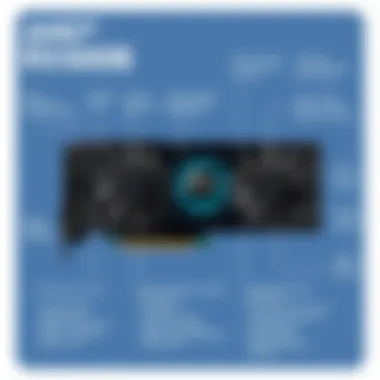

The sentiments expressed in forums are also a fantastic reflection of the evolving tech landscape. Such discussions often reveal trends toward the future of gaming technology — including rays of speculation on how AMD and rival companies might push their cards in the evolving gaming market. In synthesizing these perspectives, potential buyers can gauge where the RX 6600 stands in the broader competitive arena.
In summary, user feedback and community insights not only add depth to understanding the RX 6600's performance but also provide broader context. They can assist buyers in crafting expectations aligned with real-world performance, ultimately leading to more satisfying experiences with their tech purchases.
For further understanding, consult sources like Wikipedia or discussions on Reddit.
Price and Value Proposition
In today's competitive GPU market, understanding the pricing and value of graphics cards like the AMD Radeon RX 6600 8GB is absolutely essential for gamers and tech enthusiasts. The financial investment involved not only influences purchasing decisions but also impacts long-term satisfaction with the product. Thus, it becomes crucial to analyze its current market pricing and how it stacks up against alternatives. This section will address the key aspects that contribute to the RX 6600 8GB's value proposition.
Current Market Pricing
The RX 6600 8GB is positioned as a mid-range GPU, which means it generally appeals to consumers seeking a balance between price and performance. As of recent market trends, prices for the RX 6600 typically fluctuate between $250 to $300. However, prices can vary based on several factors:
- Retailer Promotions: Discounts and bundles can affect the final price.
- Availability: Scarcity can drive up prices, especially during high-demand seasons.
- Regional Differences: Import tariffs and local market conditions can change costs significantly.
For example, a quick check on prominent tech retailers or platforms such as Newegg or Micro Center often shows varied pricing strategies, which may lead to savvy shoppers finding it at even lower prices during sales events or holiday discounts. Keeping an eye on these fluctuations is vital for buyers who want to maximize their budget.
Cost-Effectiveness Against Alternatives
When comparing the RX 6600 to its competitors, value for the money becomes a decisive factor. Users must weigh performance metrics against the asking price of rival models. Here’s what to consider:
- Performance per Dollar: One of the RX 6600’s standout features is its ability to deliver decent performance at lower settings for most modern titles. It often outperforms others in the same price bracket, such as NVIDIA's GTX 1660 Super, making it a compelling choice for budget gamers.
- Longevity: Investing in the RX 6600 can offer greater longevity for a gaming setup, thanks to its 8GB VRAM. This ensures it can handle upcoming titles for a few years down the line without much hassle.
- Resale Value: Mid-range cards traditionally hold their worth better compared to entry-level options. Should you decide to upgrade in the future, the RX 6600 might fetch a better resale price, softening the blow of your initial investment.
"For users focused on maximizing their gaming experience without breaking the bank, the RX 6600 stands out as a prime candidate. Its balance of specs and pricing makes it a strong contender in a crowded field."
Future Prospects and Market Trends
The landscape of graphics cards is constantly shifting, driven by technological advances and ever-evolving gaming demands. Within this context, the AMD Radeon RX 6600 8GB stands as an intriguing player. Its future prospects and relevance in the market is not just a matter of curiosity, but of strategic significance for gamers and industry professionals alike.
Understanding future trends in the graphics card market offers substantial benefits. For one, it allows consumers to make informed decisions when investing in hardware. Knowing what innovations are on the horizon can also help users anticipate when upgrades will be necessary, enabling them to better align their budgets and gaming needs.
Expected Industry Innovations
The realm of graphics technology is impacted by several key innovations expected to unfold in the coming years. Among these advancements, demands for higher frame rates and better ray tracing capabilities, which are increasingly becoming standard expectations for gaming experiences.
- AI and Machine Learning Optimization: The integration of artificial intelligence in rendering processes has the potential to revolutionize performance. These systems can optimize graphics in real-time, enhancing efficiency and minimizing lag.
- Enhanced Ray Tracing: While the RX 6600 has ray tracing capabilities, improvements in this area will likely elevate the performance of future GPUs even further. Newer architectures may leverage better algorithms that enhance the realism of lighting and shadows.
- Memory Technology Advancements: Potential advancements in VRAM (like GDDR7) could significantly improve data transfer speeds. This can have massive implications for gaming at high resolutions with ultra settings.
- Thermal Management Solutions: Better cooling solutions, perhaps involving advanced materials or designs, could help maintain optimal performance during intensive gaming.
The evolution of gaming demands innovation in GPU technology, which means the RX 6600 must adapt or risk obsolescence.
Long-Term Viability of the RX
Looking towards the long-term viability of the RX 6600, it becomes clear that its success hinges on several critical factors. As gaming demands increase, so too must the components designed to handle those demands.
- Performance Longevity: The RX 6600 is built with solid specifications that allow it to handle current-generation titles well, but the key question remains: how will it perform as games become more resource-intensive?
- Price vs. Performance Ratio: The RX 6600 was launched at a competitive price point. If AMD continues to offer performance enhancements while maintaining affordability, the card could remain a popular choice among budget-conscious gamers.
- Community Support and Updates: Ongoing driver updates and community support are vital for maintaining performance and compatibility with new titles. AMD's reputation for supporting their products through software means the RX 6600 could have a longer lifecycle.
- Market Trends: Finally, as new GPUs enter the market, they often drive prices down for older models. If AMD can ensure that its current offerings remain relevant in a landscape populated with powerful new cards, the RX 6600's fate will also be more secure.
For further insights into the graphics card evolution, check out resources on Wikipedia and discussions from enthusiasts on Reddit.
Finale
The conclusion serves as the final brushstroke on the canvas that is our analysis of the AMD Radeon RX 6600 8GB graphics card. Here in this section, we synthesize all the elements previously discussed, reflecting on both the capabilities and the positioning of this GPU in an ever-evolving market. This is where we've explored the intricate technical specifications, dissected performance benchmarks, and weighed user experiences alongside community feedback. It's not merely a wrap-up, but a crucial element of understanding how the RX 6600 stands in relation to other options available to tech aficionados and gamers alike.
Summary of Findings
To summarize, the AMD Radeon RX 6600 8GB showcases a commendable blend of performance and efficiency, particularly for 1080p gaming. The architecture capitalizes on RDNA's strength, offering enhanced frame rates while maintaining modest power consumption. The versatility of connectivity options — ranging from HDMI to DisplayPort — broadens its appeal, making it a viable choice for various setups. In terms of raw metrics:
- GPU Architecture: Leveraging RDNA 2 technology.
- Stream Processors: 1,792 units, contributing to its solid processing power.
- VRAM Capacity: 8GB GDDR6, ensuring smooth handling of textures in modern games.
These specifications lay a strong foundation for performance across a range of popular titles, which we've discussed in detail. Not to forget, the market positioning has been favorable; while it competes with NVIDIA's offerings, it often presents a more attractive price-to-performance ratio, especially for those solely targeting 1080p resolution.
Final Recommendations
In light of the analysis, if you're on the fence about your next GPU purchase, the RX 6600 8GB merits serious consideration. While it may not possess cutting-edge ray-tracing performance to rival more expensive cards, it excels in delivering a robust experience for traditional gaming without breaking the bank. Here are some tips for potential buyers:
- Assess Your Gaming Needs: If 1080p gaming is your target, this card will serve you well.
- Compatibility Check: Ensure your motherboard and power supply can accommodate this GPU's requirements.
- Watch for Sales: Prices fluctuate frequently, keeping an eye out for deals can save you a pretty penny.







